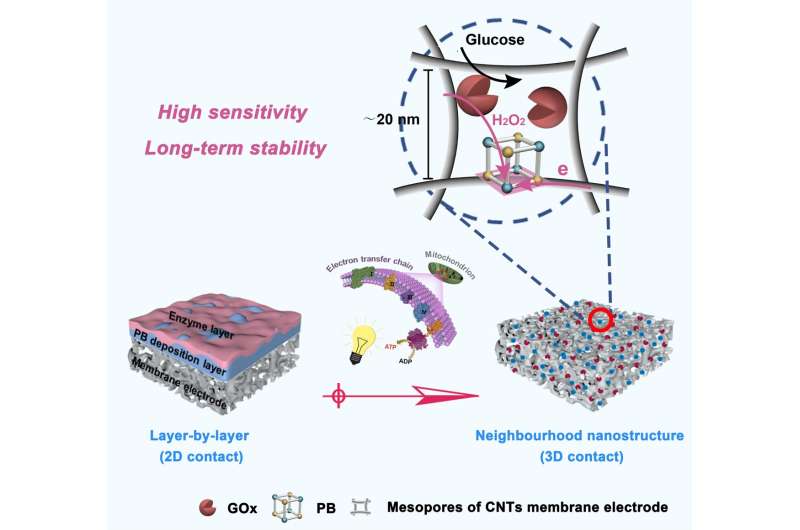Scientists develop novel biosensing-membrane for glucose detection and monitoring

Glucose oxidase (GOx)-based biosensors have attracted much attention for their potential in rapid glucose detection and continuous monitoring, which are crucial for disease diagnosis and prevention, as well as for controllable production in sugar-making and fermentation processes.
The glucose oxidase/electrocatalysts/electrode (GOx/ECs/electrode) cascade system serves as the core part of most glucose biosensing devices (both invasive and non-invasive). However, patterned assembly of these cascade sensing units remains challenging, thus limiting the attainment of high sensitivity and long-term stability.
Inspired by the structure of electron-transfer chains in the mitochondria, a research group led by Prof. Wan Yinhua from the Institute of Process Engineering (IPE) of the Chinese Academy of Sciences has developed a three-dimensional (3D) mesoporous biosensing-membrane with neighborhood nanostructures that shows excellent sensitivity and long-term stability.
The study was published in Advanced Functional Materials.
In preparing the biosensing-membranes, the researchers used tannic acid-3-aminopropyltriethoxysilane-Fe3+ (TA-APTES-Fe) ternary coating to properly assemble and adjacently confine Prussian blue (PB) and GOx in the 3D mesoporous carbon nanotube (CNT) membrane electrode.
“This strategy enhances the cascade sensing units with close proximity and extends the triple-phase boundary (TPB) from conventional 2D contact to 3D contact, which boosts the cascade reaction efficiency, improves the accessibility and availability of H2O2 toward the TPB, and increases the utilization of PB,” said Prof. Luo Jianquan from IPE.
Moreover, the spatially confined microenvironment stabilizes PB and GOx. The separation function of the CNT membrane further intensifies the sensing stability by in-situ removal of interferents from the analytes.
The as-prepared mesoporous biosensing-membrane exhibits good sensitivity and long-term stability with a negligible response drift for up to eight hours, thus outperforming the reported results.
“The multienzyme mimic functions of PB have been employed to imitate the ‘loosening-degradation’ membrane cleaning process, fully regenerating the fouled biosensing-membrane,” said Prof. Wan.
This work provides a novel design and operation strategy for biosensors, ensuring efficient, reliable, and stable sensing.
More information:
Siqing Song et al, 3D Neighborhood Nanostructure Reinforces Biosensing Membrane, Advanced Functional Materials (2023). DOI: 10.1002/adfm.202303313
Citation:
Scientists develop novel biosensing-membrane for glucose detection and monitoring (2023, June 14)
retrieved 15 June 2023
from https://phys.org/news/2023-06-scientists-biosensing-membrane-glucose.html
This document is subject to copyright. Apart from any fair dealing for the purpose of private study or research, no
part may be reproduced without the written permission. The content is provided for information purposes only.
For all the latest Science News Click Here
For the latest news and updates, follow us on Google News.

